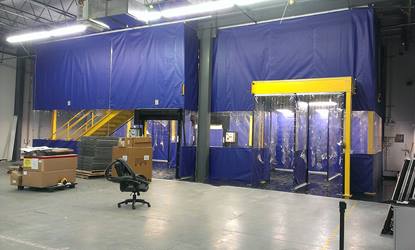- Home
- News
- Dust control Curtain walls aid exhaust methods
Dust control Curtain walls aid exhaust methods
At the very least, dust or particulate matter in the air is a nuisance. Particulate generated from cutting, grinding, mixing, etc., can settle on surfaces significant distances from the operation if containment equipment is not in place. Dust on neighboring equipment, furniture, office equipment, windows and floors is a constant drain on cleaning and maintenance resources.
Dust can cause serious quality and safety issues as well. Uncontrolled particulate matter can spoil or degrade batches of differing critical materials, whether in chemical processing or food processing. And high enough concentrations of air-borne dust-sized particulate in a closed space can become explosive or flammable.
Plus, airborne dust can be a health hazard. Hazards range from a skin, eye or bronchial irritation to more serious issues for people with asthma. Most serious is the potential for particulates to cause lung disease like cancer (extremely thorough dust control is a critical component in asbestos remediation).
Ways to control dust
Several methods can keep particulate from one space from contaminating another, including:
- Local exhaust- a high-velocity airflow stream captures particles at the point they are generated and carries them away.
- Exhaust with filtration- a high-velocity airflow stream captures particles and recirculates them through a filter medium, where they are removed.
- Area exhaust- a high-volume exhaust fan draws air from the full room volume to an outside vent or recirculates through a filtration/separation device.
- Barrier separation- simply a wall or partition between affected areas.
Either local or area exhaust most likely will include some type of filtration or particle separator in line to remove particulate from the air stream. This is necessary prior to either recirculation of the air back into the space or discharge of the air into the atmosphere.
Fabric curtain walls
Anytime a space is to be exhausted, the smaller the space can be made, the smaller the exhaust equipment can be specified. Partitioning around dust source with a fabric curtain wall takes full advantage of this relationship. By reducing the volume of the space to be exhausted, smaller fan(s) can be used, with less total air movement being required. Lower air velocity through filter media increases the effective particle separation of the device. And lower air flow through the filter reduces the frequency required for change out or cleaning.

Fabric curtain walls also act as an effective physical barrier, blocking transfer of dust particles from space to space. Curtain walls can be single layer fabric, or multi-layer insulated. They can easily be fitted with clear vision panels for visual communication between spaces.
Curtain walls are flexible by nature, yet durable, and can withstand contact from machinery or product, and simply "bend without breaking." They are also relatively easy to reconfigure if a space needs to be enlarged or reduced, or the shape of the space footprint needs to change. Fabric curtain walls are easily installed, can be simply trimmed around conduit, piping, ductwork, etc., and can be anchored to the floor to withstand pressure differential across them.
Depending on the application, a curtail wall can be suspended from the room ceiling, or hung from a supplied standalone framework. They are available as stationary as well as sliding (suspended from roller track), and can be fitted with strip curtains, personnel doors, or high-speed industrial doors for full range of access to the space.
As a simple economical way to partition space, curtail walls make exhaust and separation systems for dust more efficient. And their flexibility, reconfigurable nature and ease of installation saves companies time and money.
Back to News